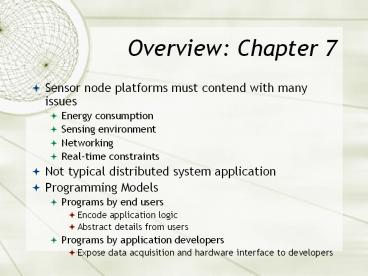Overview: Chapter 7 PowerPoint PPT Presentation
Title: Overview: Chapter 7
1
Overview Chapter 7
- Sensor node platforms must contend with many
issues - Energy consumption
- Sensing environment
- Networking
- Real-time constraints
- Not typical distributed system application
- Programming Models
- Programs by end users
- Encode application logic
- Abstract details from users
- Programs by application developers
- Expose data acquisition and hardware interface to
developers
2
Sensor Node Hardware
- Categories
- Augmented general purpose
- PC104, Sensoria WINS NG, PDAs
- Commercial off-the-shelf (COTS) OS components
Wndows CE, Linux, Bluetooth, IEEE 802.11 - Dedicated embedded sensor nodes
- Berkeley motes, UCLA Medusa, Ember nodes, MIT
?AMP - COTS chip sets (small form factors), programming
languages(e.g., C) - System-on-chip (SoC)
- Smart dust, BWRC picoradio nodes, PASTA nodes
3
Berkeley Motes
- Limited memory
- Program memory 8 - 128 KB
- RAM 0.5 - 4 KB
- External storage (Flash) 32 - 512 KB
- Limited Communication
- Max 50 kbps (with hardware acccel.)
- Energy savings is important
- 12 mA to transmit data
4
Programming Challenges
- Traditional programming models not suitable
- Programmer must handle with messaging,
networking, event synch., interrupts etc. - Embedded OS (if any) expose hardware details to
programmer - Distributed algorithms/data structures difficult
to implement - Respond to multiple stimuli quickly
5
Software Platforms TinyOS
- Targeted for resource constrained platforms
(motes) - Small memory footprint
- No filesystem
- Only static memory allocation
- Software made up of components
- Components create tasks and added to task
scheduler - Tasks run to completion no preempting by other
tasks - Events interrupts from hardware
- Run to completion, can preempt tasks
6
Software Platforms nesC
- Extension of C for TinyOS
- Components
- Interface
- Defines what functionality component uses and
provides - Implementations
- Modules written in C-like syntax
- Configurations connect interfaces of existing
components - Cuncurrency
- Asynchronous code (AC) vs. Synchronous code (SC)
- SC atomic w.r.t. other SC
- Programmers must understand concurrency issues in
code
7
Software Platforms TinyGALS
- Dataflow language
- Programming model
- Supports all TinyOS components
- Construct asynch. actors from synch. components
- Construct application by connecting asynch.
components through FIFO queues - Code Generation
- Map high-level constructs to low-level code for
motes - Automatically generate code for scheduling, event
handling, FIFO queues
8
Node-Level Simulators
- Sensor node model
- Mobility of nodes
- Energy consumption
- Communication model
- Capture details of communication (RF propagation
delay, MAC layer etc.) - Physical environmental model
- Model physical phenomena in operating environment
- Statistics and visualization
- Collect results for analysis
9
Node-Level Simulator ns-2 TOSSIM
- ns-2
- Originally developed for wired networks
- Extensions for sensor nodes
- Node locations vs. logical addresses
- Energy models
- Physical phenomena
- TOSSIM
- Simulator for TinyOS apps on Berkeley motes
- Compiles nesC source into simulator components
10
State-Centric Programming
- Applications more than simple distributed
programs - Applications depend on state of physical
environment - Collaboration Groups
- Set of entities that contribute to state updates
- Abstracts network topology and communication
protocols - Multi-target tracking problem
- Global state decoupled into separate pieces
- Each piece managed by different principal
- State updated by looking at inputs from other
principals - Collaboration groups define communication and
roles of each principal

